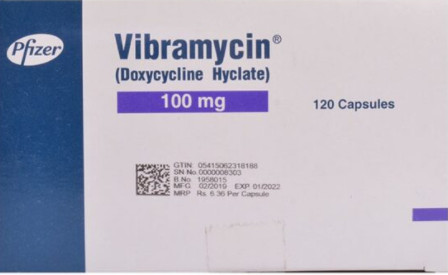
Indications
- Acne vulgaris : Start at 100 mg once daily or twice daily and decrease the dosage once control is obtained.
- Papulopustular rosacea : 40 mg daily for 4–8 weeks(FDA approved) or 50–100 mg once or twice daily.
- Steroid rosacea : 100 mg once or twice a day.
- Ocular Rosacea :100 mg once or twice daily.
- Perioral dermatitis : 40 mg once daily.
- Hidradenitis suppurativa :100 mg twice daily may prevent disease activation.
- Bullous pemphigoid :100 mg twice daily.
- Hailey-Hailey disease :100 mg daily may be continued for at least 3 months to gain control.
- Cutaneous sarcoidosis: 200 mg daily.
- Confluent and reticulated papillomatosis: 100 mg twice a day.
- Prurigo pigmentosa : 200 mg daily.
- α1‐antitrypsin deficiency panniculitis: 200 mg twice daily for 3 months
- Cold urticaria: 200 mg per day for 3 weeks.
- Acute febrile neutrophilic dermatosis: 200 mg daily.
- Erythema migrans :100 mg po BID for 14 days.
- Mild bowel associated dermatosis arthritis syndrome : 100 mg once to twice daily,
- Suspected MRSA infection :100 mg PO 2 times a day.
- Rickettsial infections: 100 mg po or iv twice daily.
- Early syphilis for penicillin-allergic patients :100 mg po BID for 14 days.
- Late latent for penicillin-allergic patients :100 mg po BID for 28 days.
- Lymphogranuloma venereum :100 mg po twice daily.
- Granuloma inguinale : 100 mg po BID until all lesions completely healed (at least 3 weeks).
- Anthrax.
- Atypical mycobacterial infections.
- Granuloma annulare: 100 mg daily.
- Perforating dermatoses: 100 mg daily.
Dosage
- Bacterial infection: 100 mg PO/IV bid.
- Sub-antimicrobial dose : 20 mg PO bid.
Mechanism of action
- Bacteriostatic agents that inhibit bacterial protein synthesis by targeting the 30S ribosomal subunit of both gram‐positive and gram‐negative bacteria.
- Anti‐inflammatory : inhibition of MMPs function.
Side effects
COMMON: dyspepsia, nausea, vomiting, anorexia, diarrhea, stomatitis, candidiasis, discolored teeth (<8 years old), esophagitis,
phlebitis (IV), lightheadedness, dizziness, vertigo, ataxia, headache, tinnitus, drowsiness, photosensitivity.
RARE: pseudotumor cerebri (with isotretinoin), neutropenia, thrombocytopenia, hepatotoxicity, Jarisch-Herxheimer reaction (when treating Treponema pallidum), superinfection, pseudomembranous colitis, increased intracranial pressure (infants), skeletal retardation (infants).
Contraindications
- Hypersensitivity to drug/class.
- Pregnancy, children, impaired liver or renal function.
Interactions
- Absorption is impaired by polyvalent cations such as calcium, aluminum, magnesium, iron, zinc, and bismuth.
- Antacids, some laxatives, medications containing magnesium (e.g. quinapril), dietary supplements, and dairy products can inhibit absorption.
- Antacids, H2 blockers, and proton pump inhibitors increase stomach pH and thereby decrease absorption.
- Potential toxicity of digoxin, lithium and warfarin.
- Barbiturates, phenytoin, and carbamazepine decrease the half-life of doxycycline.
Pregnancy &Lactation
- Pregnancy category D.
- Doxycycline is excreted in breast milk, potentially leading to staining of the deciduous teeth, enamel hypoplasia, and impaired skeletal growth in developing fetuses and nursing infant.
Precautions
- Caution is warranted when prescribing doxycycline for patients with severe liver disease.
- Not recommended for persons aged, 8 years to avoid tooth discoloration.
- To decrease the likelihood of esophagitis, the pills should not be “dry swallowed” and should be taken at least half an hour prior to bedtime
Drug Info
- Doxycycline, which is excreted primarily by the GI tract in bile and can be used in patients with renal failure.
- The incidence of photosensitivity is low but increases with increasing dose levels.
- Doxycycline may be taken with or without food, but it is preferred to be taken with food to avoid gastrointestinal upset.
- Modifed‐release (subantimicrobial) preparations of doxycycline appear to minimize the development of antibiotic resistance without loss of anti‐inflammatory effect.
Was this helpful?
2 / 0
#Doxycycline #Doxycycline indications in dermatology